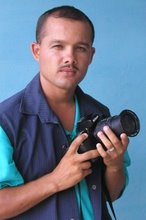Text and photos: Amauris Betancourt.

The Harlequin I Have Inside, new cultural meeting from the Provincial Center of the Performing Arts in Holguín, has two appointments monthly. It aims at paying homage to artists and fostering the interest for the puppet theater world.

“Gil”–as people prefer to call Fernando Gil Arias- “deserves the attention of all of my city’s cultural institutions,” says Ignacio Figueredo Parra, producer and director of the gathering, and adds “I believe the way a man honors his name as an artist is creating. There are many people who consider him an ACTOR”.
Gil graduates from his native Manzanillo’s teacher’s art school, in the province of Granma. He arrives in Holguin in 1979 to work as an art teacher for the local puppet theater. He founds later the Julio Antonio Mella theater group from the Cuban National Worker’s Union and the children Gil-Aya theater project. Gil, his surname; Aya, the word in Spanish for the one who takes care and teaches children.
Gil treasures the 2005 Holguin City Award. Although he currently works for and directs Holguín's Dramatic Theater since 2001, he has left footprints in television, the puppet theater and the attrezzo world.

Gil evokes his experiences, among good and bad memories, of over 30 years devoted to the stage with an aura of nostalgia. His character as the goat has marked him. Many call him so nowadays. He must interpret once two characters: first the goat and then the cock, but he forgets to change over the mask. His artistic experience and professionalism let him off the hook by taking advantage of the situation for the sake of the spectacle, but the anecdote is still remembered.

Performing arts people utter affection and admiration for Gil: The Puppet Theater from Holguin performs for him, the work The little Martina Cockroach; and he talks about the skills of puppeteers in comparison with theater player: the former must insufflate energy and credibility to the puppet; the latter, must do it directly with his body.
He recalls the Gil-Aya project as one of his most wonderful experiences. Children, according to the project, have an appointment with him and his collaborators in the Alba's ruins, the current homonymous Academy of Plastic Arts. Hundred of children meet there, but only a hundred of them could come in. The entrance of parents or adults is forbidden: children should be picked up four hours later.
The project proves to be quite polemic. Doctors suggest it to parents, but colleagues in art question it. Even so parents and doctors trust the meeting and the gathering earns besides followers, a good reputation from the artistic point of view.

Year Zero and Gods Listen from Codanza Ballet Co. are some of his contributions to the attrezzo world, that’s why Codanza plays for him too with Ode to the Devil; and so does also the

Holguín's Chamber Ballet.
Eugenio Hernández Espinosa, José Antonio Rodríguez, Michaelis Cué and Ana María Paredes are included among his masters and friends, among the professionals who he looks up to.
Gil longs for a better future than the present for the puppet theater and for the performing arts in the city. There is a lamentable worn-out in some cultural institutions, he states; and they are no longer up to the aim they were created for as for the technological and artistic state.

The Harlequin I Have inside has had a happy beginning. The following gathering is already looked forward. The city has another cultural space to admire artists and to recreate the Cuban art.
 The health center gives also medical aids to the provinces of Granma and Las Tunas, stated Dr. Teresa Guillén, director of the hospital, when expressing her satisfaction at the head of a team where human and moral values prevail.
The health center gives also medical aids to the provinces of Granma and Las Tunas, stated Dr. Teresa Guillén, director of the hospital, when expressing her satisfaction at the head of a team where human and moral values prevail. Holguín's Surgical Hospital has been successful in renal transplants, in general surgery, in the introduction of new surgical techniques – videoendoscopics, for example –, and the only institution in Cuba in the practice of 24-hour-a-day minimum access surgery, said doctor second grade specialist surgeon Rosell Batista Feria, hospital founder.
Holguín's Surgical Hospital has been successful in renal transplants, in general surgery, in the introduction of new surgical techniques – videoendoscopics, for example –, and the only institution in Cuba in the practice of 24-hour-a-day minimum access surgery, said doctor second grade specialist surgeon Rosell Batista Feria, hospital founder. 
 Imagenology, privileged area, includes technologies such as Nuclear Magnetic Resonance, mono and multi-cut computerized Axial Scanners, Densitometers, Doopler and conventional Ultrasound, X-Rays among others.
Imagenology, privileged area, includes technologies such as Nuclear Magnetic Resonance, mono and multi-cut computerized Axial Scanners, Densitometers, Doopler and conventional Ultrasound, X-Rays among others.  The provincial Ophthalmology Unit, inaugurated recently and updated with the most modern technology like the Excimer Laser introduced today, has assisted and intervened surgically about three thousand patients in less than a year.
The provincial Ophthalmology Unit, inaugurated recently and updated with the most modern technology like the Excimer Laser introduced today, has assisted and intervened surgically about three thousand patients in less than a year.
 People from Holguín thank and congratulate the Lucía Iñiguez hospital's working people.
People from Holguín thank and congratulate the Lucía Iñiguez hospital's working people.























